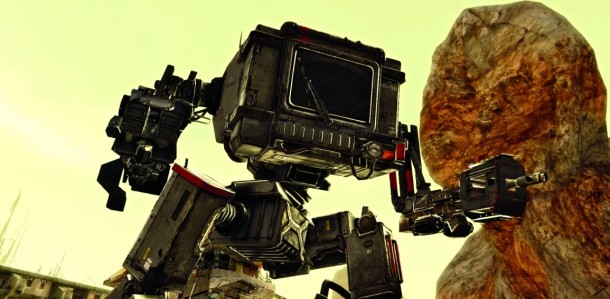Our Verdict
Theyve nailed the sensation of stomping around in a giant machine, but the F2P model needs an oil change.
PC Gamer's got your back
This review is based on the open beta version of Hawken, with its final release not due till 2013. We felt we had to review it at this point as it's possible to spend money inside the game, and it's our responsibility to provide timely buyer's advice to readers. We'll update this review should the game significantly change between now and release, to make sure it reflects the current state of the game.
They may look like unwieldy lumps of steel, but Hawken's war machines are surprisingly agile. Meteor's free-to-play shooter gives you control of a twenty-foot-tall mechanical warrior, but it's not another MechWarrior: the maps here are small, and the combat snappy.
It's all about the movement. As my mech thuds around, the cockpit wobbles and dirt flecks the windshield. I hear the mechanical clank of each heavy footstep, and when I fire my weapons I can sense the vibrations rattling my chassis. When I move the mouse to turn, there's a slight delay and the whir of a motor as my robo-head swivels around. I haven't felt as physically connected to a first-person game since Mirror's Edge.
It's the ability to dash that gives Hawken's machines the edge over their squishy human peers. Press Shift + W and a back-mounted jet engine will ignite and propel you forwards. This is considerably faster than walking, but uses fuel, of which you have a limited – but constantly regenerating – supply. Hitting Shift and a direction key enables you to dart out of the way of incoming missiles, although it takes practice. You can hover by holding Space, and a good way to confuse an opponent is to float over their head, then launch missiles into their back before they can reorient themselves.
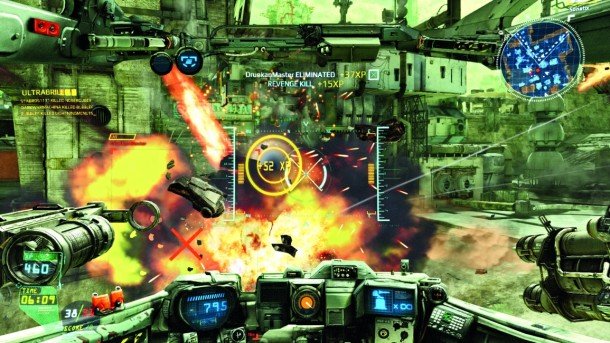
When you nail the timing, you get a feeling of immense satisfaction in sidestepping a rocket at the last second, launching into the air, then raining death on whoever fired it.
Streaking in and out of cover to avoid explosive projectiles is the hallmark of a skilled player, as is unpredictable movement – deftly combining boosting, dashing and hovering. Seeing two accomplished players pirouette around each other is an impressive sight – or a depressing one, depending on how good you are, and how much money and time you're willing to plunge into Hawken's free-to-play economy.
The more time you spend with the game's mechs, the better they get, both in terms of the free-to-play bolt-ons you can add on to specialise them, and the familiarity you gain with your robot friend over the course of repeat battles. Battles also garner you experience for the vehicles in your persistent garage.
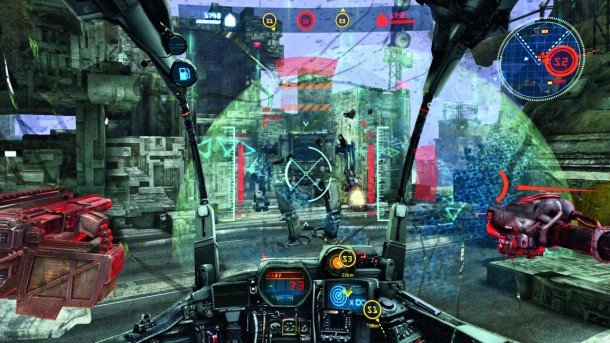
There are some issues with combat feedback. It can be difficult to tell whether your bullets are connecting or not in the hysteria of battle. Health bars get lost in the dense, cluttered scenery of the maps, and there's no sense of impact from a connecting shot. When multiple players engage in combat in the same area, your vision becomes obscured by explosions, dust, smoke and the bulky frames of other mechs wobbling around in your crosshairs like angry household appliances. This all adds to the physical sensation of piloting a mech, but also makes busier firefights confusing.
Melee attacks are notable in their absence. The ability to whack enemies from behind like naughty robo-children would be a welcome addition, even as an optional – and hilarious – upgrade. The abundance of blind corners in the game's maps means you always end up cockpit-to-cockpit with other players, and it would be good if there was another way to react to those situations other than strafing backwards in panic.
There are nine classes, each offering a different play style. The game also gives each mech a difficulty rating. At the boring low end there's the Assault, a lightweight all-rounder that combines a medium range rifle with a TOW rocket launcher. Assault mechs are easy to use, but lack personality, like an off-brand toaster. The Rocketeer is more of a challenge, but a powerhouse in the right hands. Hold your crosshair over an opponent as you fire your Seeker rockets and they'll thunk into its armour, shredding it in seconds. The Brawler's flak cannon rips through armour at close range. The Sharpshooter is a sniper, although none of the maps really lend themselves to long-range combat. And the Scout can quickly recharge its fuel. They're all fairly standard multiplayer archetypes.
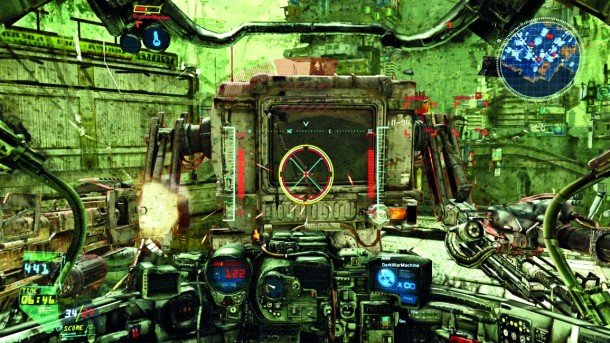
Heavier mechs like the Rocketeer can transform into mobile turrets. The metal plates on their head clamp down and form a protective shell, which makes them slow to a crawl, but toughens their armour up considerably. If someone gets behind you, you're done for, but having one of these guys at the front of a team push is mighty useful.
There are some other, less exotic, special abilities too. The Assault, for example, can instantly cool down its weapons if they overheat. And there are 'countermeasures', which have caused some controversy in the community. These consumable paid-for items enable you to instantly counter the effects of disabling attacks such as the EMP. Some say they bring an element of pay-to-win to the game, but the effects are so brief that they don't really affect the balance of a match.
If you stick with a class, you'll earn optimisation points that you can use to advance through three RPG-style skill trees. Offence increases bullet damage, fire rate, and reduces weapon heat. Defence toughens up your armour and increases your dodge speed. Movement enables you to walk faster, makes you less visible to radar, and increases your fuel regeneration rate. On top of that, you can customise your mech with internals (engine parts that give small stat boosts), weapons, and support items. These range from deployable turrets and protective shield bubbles to EMP blasts that shut down an opponent's HUD and weapons. Then there are the cosmetic upgrades, which let you change the shape of your mech or give it a gaudy neon paint job.
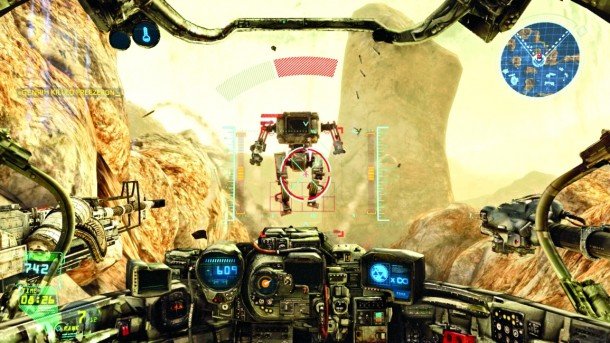
There's a lot to tinker with, but it's not deep enough that you feel like you're actually creating your own machine from scratch, and visual mods can't be earned in-game: you have to buy them. Hawken is free-to-play, and it suffers for it. When you start a new account, you're given a single Assault class mech. Hawken should have used PlanetSide 2's free-to-play model, giving you a basic, no-frills version of each class that you can then plug better parts into once you've settled on one you like, and weapon trials to take the sting out of a hefty purchase. Some people may not find the Assault class to their taste and conclude that the game itself isn't for them, but if they had a chance to try the other mechs out, they might stick around longer and eventually become a paying customer. F2P successes have proved that, even with much offered for free, people will still spend money.
Buying mechs is a gamble. You can take a handful of them out for a test run – the Rocketeer and Scout at the time of writing, and that selection looks set to revolve – but you can't customise their loadouts without committing to them. You'll have to spend 6410 Hawken Credits for that right – the result of many hours of grinding. Or you could just spend 720 Meteor Credits instead, the game's real-world currency, and save yourself the hassle. The pricing isn't bad – a mech costs roughly £4, which is about the same as a PlanetSide 2 gun – but the F2P model makes free players feel like outcasts, stuck with the boxy, unremarkable CR-T Recruit for hours, while paying players dance around them in their fancy new Bruisers and Brawlers.
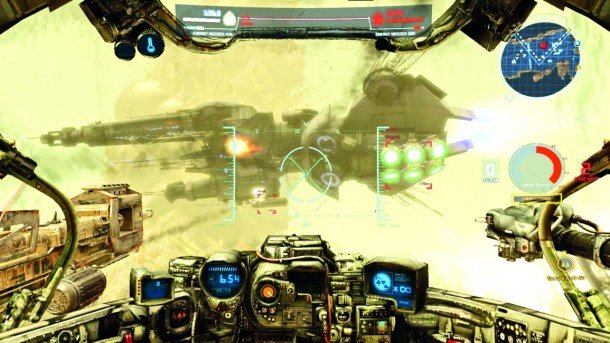
It was clever of the developers to make the starting mech the ugliest. Some players will probably end up buying Meteor Credits just so they don't have to look like an old TV with legs any more. But that aside, the game's art direction is stunning. Its vision of the future is hard and industrial; a battered, lived-in world. The mechs look like they were pieced together from scrap metal, and designed for war, rather than to look pretty. Soft, natural lighting and a subtle grain filter add a layer of grit and realism. It looks like the concept art for a '70s sci-fi film come to life. It's such a compelling universe that it almost feels wasted on the confined maps of a multiplayer shooter.
Prosk is my favourite map, boasting storm drains you can use as makeshift trenches, and rooftops to hover up to and perch on. It's a bleak, futuristic cityscape, like something from Ghost in the Shell, dotted with buzzing neon signs. Bazaar is a sand-blasted desert town, and features long, open stretches that offer Sharpshooters a rare chance to target distant enemies. Uptown is another city map, with a network of twisting corridors running through it that you can use as choke points. Origin is perhaps the most interesting in terms of verticality, with a series of stacked levels to fight on, and jump pads that spring your mech into the air. It's not an enormous selection, and they're small compared to most shooters, but they're all visually, and tactically, distinct.
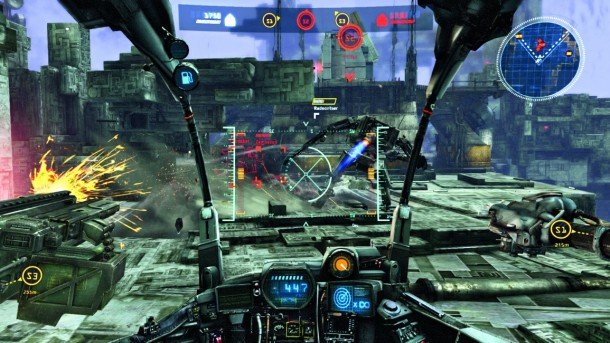
The Deathmatch and Team Deathmatch modes are entertaining enough, and the narrow maps mean that kills (and deaths) come fast. But besides the fact you're fighting against robots, there isn't much distinction between these modes and a run-of-the-mill, small-scale FPS. Kill assists are frequent, and you often find yourself finishing off mechs that other players have softened up. The action is fast and satisfying, and these battles a good way of swiftly racking up the XP necessary for item purchases, but Hawken sets itself apart from other shooters in its healing mechanic. At any time, you can hold C to heal. Your mech folds up into a ball and a tiny drone zips around it, zapping it with soothing lasers. This leaves you open to attack, but means that if you limp out of a firefight with only a sliver of health left, you can find a safe corner to repair, then come back fighting without having to respawn. It adds a layer of tactical consideration to a twitch shooter.
Missile Assault and Siege are more interesting. They're team-based games, and sticking with other players is pretty much essential to victory. Missile Assault has two sides fighting to take control of three missile silos. When a silo is held, it continually launches rockets at the enemy base. The first team to destroy the other side's base wins. It's a fun take on Battlefield's tried-and-tested Conquest mode, and more esoteric mech classes, like the Grenadier or the Rocketeer, feel more useful here. If they spot a group of enemies clustered around a silo, they can pummel the area with explosives to drive them away. You can hit Q to spot in team games, but it won't mark specific enemies; only the area of the map your crosshair is pointing at on the mini-map.
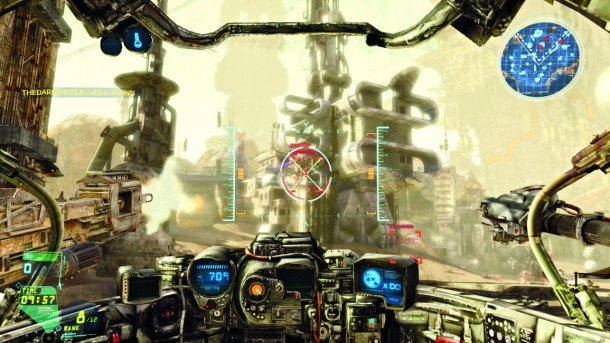
Siege is the most difficult mode to get used to, but also the most rewarding. Players have to gather energy from nodes in the centre of the map, then rush back to their base and dump it. When a certain amount is harvested, an enormous battleship is launched and heads towards the opposing team's base. When this happens, the other team has to secure an AA gun to shoot it down. When you're with a team who know what they're doing, Siege is Hawken at its best, more tactical and measured than a standard FPS but with all of that genre's innate reactivity. When you're not, it's impossible to make any progress and can be hugely frustrating. You're at the mercy of matchmaking, and there's no server browser – although this may change in the future. The game is constantly being updated and tweaked, and the community is extremely vocal.
Piloting Hawken's brawny mechs is a thrill, but the game's tight-fisted F2P structure holds it back. If you don't spend money you feel like you're being punished, and you miss out on a large portion of the game. The classes are so wildly different that saddling new players with just one feels short-sighted. Buying a new mech with Hawken Points will take many hours of dedicated play, and by then your attention will have probably wandered.
If you don't mind forking out, this is a beautiful and competent shooter with some depth. With additional maps and a more generous free-to-play model to enable players to more easily tweak their robotic steeds to some level, it could have been great.
Expect to pay: Free-to-play
Release: Out now
Developer: Adhesive Games
Publisher: Meteor Entertainment
Multiplayer: Up to 12 online
Link: www.playhawken.com
Theyve nailed the sensation of stomping around in a giant machine, but the F2P model needs an oil change.
If it’s set in space, Andy will probably write about it. He loves sci-fi, adventure games, taking screenshots, Twin Peaks, weird sims, Alien: Isolation, and anything with a good story.
